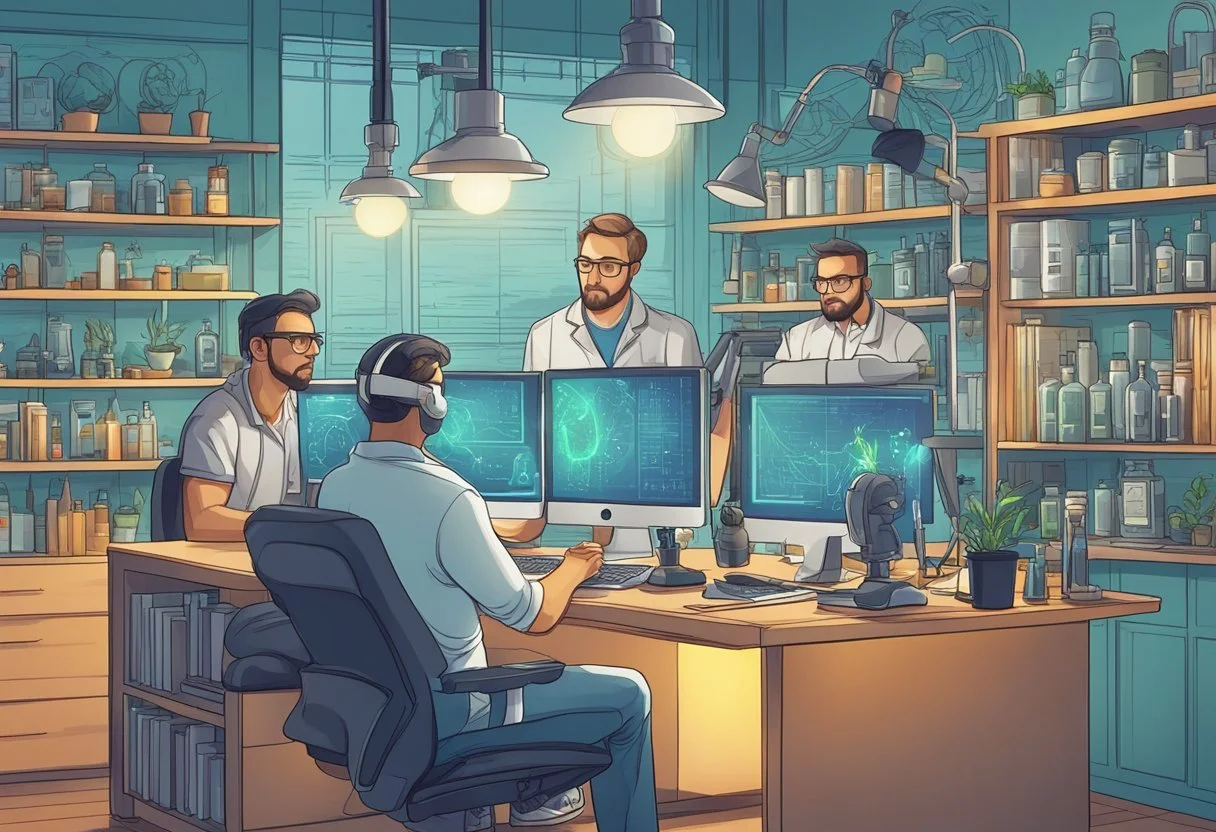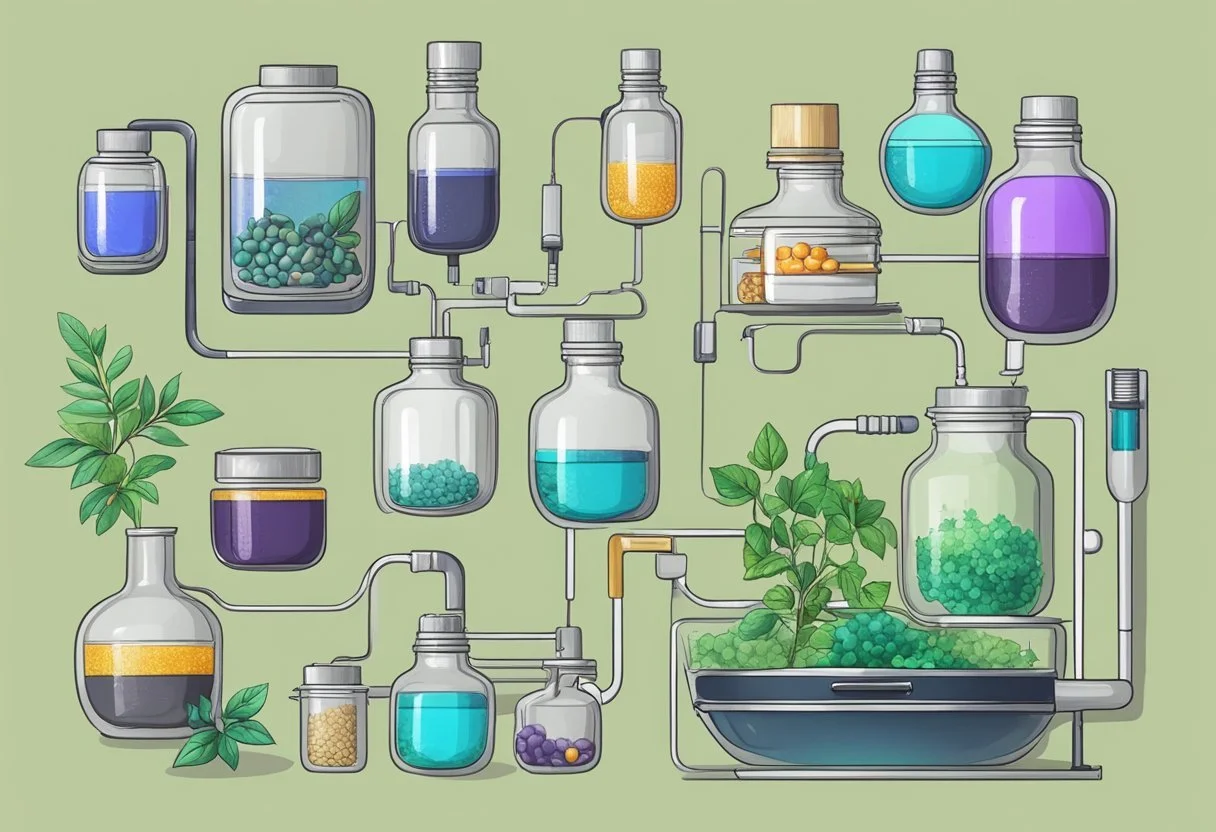What is Biohacking?
A Concise Guide to Self-Improvement Techniques
Discover > Biohacking > What is Biohacking?
So, what is biohacking? Biohacking has gained popularity in recent years, as individuals increasingly strive to take control of their own health, biology and everyday life. At its core, biohacking is a self-improvement movement in which people seek to optimize their body's potential through the use of technology and lifestyle changes. Biohackers draw on various disciplines, such as biological processes, nutrition, and even electronics, to attain a holistic understanding of their own bodies and improve their overall well-being.
The emergence of biohacking has introduced numerous techniques aimed at enhancing the body's response and performance. These methods range from simple lifestyle adjustments, such as dietary supplements and exercise, to more advanced approaches that involve genetic modification or wearable technology. While the goal is generally to achieve a better quality of life, there are inherent risks and ethical questions that arise as people push the boundaries of biology in pursuit of self-improvement.
As a field, biohacking possesses the potential to revolutionize not only personal well-being but also the broader healthcare industry. However, its true impact will ultimately depend on public perception and the willingness of individuals to embrace unconventional methods of pursuing biological enhancement.
The Origins and Basic Concepts of Biohacking
Biohacking emerged from the curious minds of Silicon Valley, where innovators and technologists sought to apply their hacking mentality to their own biology to boost performance. This approach revolves around the idea that individuals can take control of their bodies and minds in a do-it-yourself (DIY) manner, optimizing performance and well-being. Many biohackers are driven by a desire to transcend the natural limits of human beings, influenced by the ideology of transhumanism.
Its pioneers are essential to the biohacking movement, people interested in defining and promoting the different types of biohacking. For example, Jack Dorsey, a prominent figure in the tech industry, has gained attention for his commitment to biohacking practices. His approach, like that of many biohackers, focuses on diet, body weight, exercise, and mental well-being to achieve overall physical and cognitive enhancements.
DIY biology is at the core of biohacking, providing individuals with the tools and knowledge to experiment with their own biology. This practice often involves innovative techniques for tracking various aspects of personal health, such as sleep patterns, nutritional intake, and mental acuity. Biohackers collect and analyze data to identify areas of improvement and employ targeted interventions to optimize their well-being.
In summary, biohacking originated in the cutting-edge environment of Silicon Valley, driven by curiosity and a desire to push the boundaries of human potential while being aware of the risks involved. The fundamental concepts of biohacking encompass a DIY approach to biology, led by well-known figures like Jack Dorsey and inspired by the ideals of transhumanism. The practice enables individuals to take charge of their own health and well-being, seeking self-improvement through data-driven experimentation.
Forms of Biohacking: DIY Biology and Grinder Movement
Biohacking encompasses many types of biohacking, including the DIY biology movement and the grinder movement. Both of these forms of biohacking focus on self-experimentation and optimization.
DIY biology, or do-it-yourself biology, is a form of biohacking that involves individuals and groups conducting scientific research and experiments outside of traditional academic and industry settings. These biohackers often utilize easily accessible tools and technologies to explore and manipulate living organisms. Their work can include genetic engineering for the genetically predisposed, developing new biotechnologies, and creating novel biological solutions to pressing problems. While some DIY biologists may have formal scientific training, others come from diverse backgrounds, bringing a unique mix of perspectives to the field.
On the other hand, the grinder movement is centered around the augmentation of the human body through various means, often involving the implantation of devices or the alteration of physical structures. Grinders, as practitioners are often called, aim to enhance their bodies' abilities and senses by embedding magnets, sensors, and other devices into their flesh, becoming part-human, part-machine, or cyborgs. This form of biohacking also involves a strong culture of self-experimentation; grinders are known to perform their procedures and modifications on themselves or with the assistance of fellow grinders.
The engineering of these body modifications can be highly sophisticated, incorporating advanced technologies like microprocessors or feedback systems to interface with the body's natural functions. Some common examples of body modification include magnets implanted in the fingertips, which can allow grinders to sense magnetic fields, and radio-frequency identification (RFID) chips embedded under the skin, providing convenient access control or information storage.
Despite the inherent risks associated with self-experimentation and invasive procedures, grinders continue to push the boundaries of human-machine integration, aiming to fuse the organic and the synthetic in pursuit of enhanced biological capabilities. The grinder biohacking movement raises important questions about the nature of the human body, our relationship with technology, and the ethical implications of self-modification.
In conclusion, both DIY biology and the grinder movement represent distinct forms of biohacking, characterized by a shared emphasis on self-experimentation and exploration. These movements continue to evolve and push the boundaries of what is possible, redefining our understanding of biology, technology, and the human experience.
Notable Personalities in Biohacking
Among the many individuals exploring the world of biohacking, Dave Asprey is a standout figure. He is known as the "father of biohacking" and is the creator of Bulletproof Coffee, a caffeine concoction that gained popularity for its supposed cognitive-enhancing properties. Asprey has spent over two decades researching and experimenting with biohacks to improve brain function, weight loss, and improve overall wellness. He has written several books on the topic, including "The Bulletproof Diet" and "Head Strong."
Some hackers have also contributed to the biohacking movement by developing innovative technologies and opening up new possibilities for self-enhancement. For instance, they have created devices for tracking bodily functions, such as heart rate and blood sugar. These hackers often share their knowledge through forums, community labs, conventions, and online platforms, making biohacking techniques more accessible to the general public.
While biohacking is still a relatively new and evolving field, these notable personalities significantly drive its growth and shape its future trajectory. By sharing their knowledge and experiences, they continue to inspire others to explore the potential benefits and applications of biohacking in their own lives while remaining aware of the safety risks.
Diet and Nutrition in Biohacking
Biohacking focuses on optimizing the body's performance through various methods, and diet and nutrition play a crucial role in this process. By making specific dietary choices, biohackers can influence factors like weight, insulin resistance, and energy levels. It is hoped in time biohacking advances may one day assist in reducing the symptoms of metabolic and brain disorders.
One popular approach within biohacking is intermittent fasting or alternate day fasting. This practice involves cycling between periods of eating and fasting, which can help improve insulin sensitivity, regulate weight, and support overall health. Some biohackers combine intermittent fasting with the Bulletproof Diet, a diet plan emphasizing healthy fats, high-quality protein, and low carbohydrates.
Another essential aspect of diet and nutrition in biohacking is selecting nutrient-dense foods, such as vegetables, grass-fed beef, and healthy fats. These choices promote optimal brain function and overall well-being. Ideally, biohackers should prioritize clean, whole foods over processed or sugary alternatives.
In addition to whole foods, biohackers often incorporate supplements into their nutritional regimen. These can range from vitamins and minerals to more specialized compounds, such as adaptogens or nootropics. The goal is to provide the body with additional support and nutrients that may not be readily obtained through diet alone.
Caffeine can be a helpful tool in biohacking, particularly when used strategically. For example, coffee contains antioxidants and can promote mental focus. Some biohackers even use a technique called Bulletproof Coffee, which involves blending coffee with grass-fed butter and medium-chain triglyceride (MCT) oil to create a high-energy, nutrient-dense beverage. However, being mindful of caffeine intake is essential, as excessive consumption can lead to negative side effects.
Lastly, an elimination diet can be beneficial in identifying food sensitivities and optimizing nutrition. By removing potentially problematic foods, such as dairy or gluten, biohackers can pinpoint triggers for inflammation or digestive issues and make personalized dietary adjustments for those with eating disorders for example.
In summary, among the different scientific fields of biohacking diet and nutrition play a vital role. Biohackers can optimize their body's performance and support overall health by focusing on nutrient-dense foods, incorporating supplements, and making strategic choices about caffeine and fasting.
Techniques and Practices used in Biohacking
Biohacking encompasses a wide range of practices aimed at optimizing physical and mental well-being. Generally, biohackers seek to improve their health and performance through self-experimentation on brain gene networks, incorporating various methods and science. Some common techniques and practices in biohacking include:
Meditation: This age-old practice is known for promoting relaxation and reducing stress. By focusing on breath and mindfulness, meditation can help calm the mind, improve cognitive performance, and aid with certain health problems.
Sleep optimization: Quality sleep is crucial for overall health and mental clarity. Biohackers often track their sleep patterns to identify areas of improvement by reducing brain activity. Adjusting sleep environment, using sleep aids, or maintaining a regular sleep schedule can lead to better, more restful sleep.
Exercise: Regular physical activity is a core component of biohacking. Different forms of exercise, such as strength training, cardiovascular workouts, and yoga, can help maintain optimal athletic performance, cognitive performance and reduce anxiety.
Ice baths and cryotherapy: Science informs us that exposure to cold temperatures reduces inflammation, speeds up recovery, and boosts overall well-being. While ice baths involve immersing oneself in ice-cold water, cryotherapy uses a chamber with extremely cold air.
Neurofeedback: This method involves monitoring brainwave frequencies and using auditory or visual feedback to guide the user toward desired brainwave patterns. It can help enhance focus, reduce stress, and improve overall mental performance.
Blood tests and biomarker tracking: Regular blood testing and monitoring of biomarkers can provide valuable insights about an individual's health. Biohackers use this information to fine-tune their health strategies, making necessary changes to their diet, exercise, and supplement regimen.
Stem cell therapy: This innovative treatment uses stem cells, which have the potential to develop into various cell types, to promote healing and regeneration in the body. Some biohackers undergo stem cell infusions or genetic biohacking to improve their health and potentially slow aging.
Hyperbaric oxygen therapy (HBOT): Spending time in a hyperbaric chamber exposes the body to increased oxygen levels, which can boost healing, reduce inflammation, and promote overall well-being.
Infrared light therapy: This treatment uses infrared light to improve skin health, reduce inflammation, and promote relaxation. Many biohackers utilize infrared saunas or infrared light-emitting devices as part of their wellness routines.
Brainwave entrainment: This technique involves the use of sound, light, or electromagnetic frequencies to synchronize brain waves with the desired frequency. This can help improve focus, relaxation, and overall mental performance.
Young blood transfusions: This controversial practice involves transfusing blood from younger individuals into older recipients to improve health and slow the aging process potentially. However, more research is needed by a medical professional to understand its safety and efficacy fully.
Incorporating these techniques and practices into a biohacking routine allows individuals to take control of their health and optimize their physical and mental performance. By integrating new technologies and methods, biohackers continue to push the boundaries of human potential and the future of genetic makeup.
Biohacking for Mental and Physical Performance
Biohacking, a self-improvement approach, has emerged to optimize mental and physical performance. Enthusiasts employ various methods, such as lifestyle changes, brain exercises, and smart drugs to augment their capabilities. A significant part of biohacking emphasizes enhancing brain function, mental performance, and productivity, while reducing the symptoms of some brain disorders.
One method to boost mental performance involves the use of smart drugs or nootropics. These substances, which include caffeine, modafinil, and racetams, are believed to improve cognitive functions like memory, creativity, and decision-making. However, users should exercise caution and consult with a physician before trying smart drugs to avoid negative side effects.
Apart from smart drugs, biohacking also incorporates nutritional supplements like creatine. Not only does creatine provide physical performance benefits (e.g., increased strength and muscle mass), but it has also been shown to improve cognitive function by helping the brain maintain energy levels under stress.
Weight loss is another facet of biohacking that supports overall health. Utilizing strategies like intermittent fasting, carbohydrate cycling, and high-intensity interval training (HIIT) can boost metabolism, burn fat and reduce heart disease. Coupled with a healthy diet rich in micronutrients and vitamins, these methods can help individuals achieve and maintain a desirable body composition.
To sum up, biohacking targets both mental and physical performance through various techniques, such as smart drugs, nutritional supplements, and personalized fitness plans. While it's essential to approach biohacking cautiously, incorporating these strategies may lead to improved brain function, increased productivity, and enhanced health.
Biohacking Tools and Gear
Biohacking involves using various tools and gear to manipulate and enhance the human body's capabilities. Some common biohacking tools and gear include implanted devices, smartwatches, hyperbaric chambers, and practices related to quantified self.
Implants are one form of biohacking, where small devices or substances are placed inside the body to enhance its functions. These can range from microchips for monitoring body temperature and vital signs, to magnets that provide users with a new form of sensory input.
Smartwatches play a significant role in biohacking, as they offer various tracking features, such as heart rate monitoring, step counting, and sleep tracking. These devices help biohackers track and analyze data related to their physical and mental health, enabling informed decisions about exercise, sleep, and nutrition.
Hyperbaric chambers are another tool used by biohackers to improve overall health and wellness. These chambers increase the oxygen concentration in the air, which can aid in healing and potentially enhance physical performance. Some biohackers use hyperbaric chambers to speed up recovery from injuries or improve athletic ability.
The concept of quantified self is central to biohacking. It involves individuals self-tracking various metrics related to their mind, body, and environment. This can include tracking sleep patterns, exercise habits, heart rate, and other markers of wellbeing. This data-driven approach helps biohackers identify patterns in their daily lives, enabling them to optimize their activities for improved health and performance.
In conclusion, biohacking tools and gear encompass a wide range of devices and practices designed to enhance human performance and wellbeing. By tracking various metrics and using specialized equipment, biohackers seek to optimize their lives through data-driven decision-making.
Risks and Safety Concerns in Biohacking
Biohacking, the practice of experimenting with biology to improve one's physical and mental capabilities, has attracted a growing number of enthusiasts. While biohacking can offer potential benefits, there are also several risks and safety concerns that individuals should be aware of before diving into this field.
First and foremost, biohackers often carry out experiments on themselves, raising ethical and safety concerns. Without proper medical supervision or adherence to established safety practices, these individuals may be exposing themselves to harm. For example, some biohackers use gene-editing tools like CRISPR to modify their own DNA, a potentially dangerous endeavor with unknown long-term side effects.
In self-experimentation, there is a risk of causing unintended consequences and potentially irreversible impacts on one's health. Additionally, using experimental techniques and substances not approved by the FDA increases the danger, as these have not been vetted for safety or efficacy.
Another concern associated with biohacking is the possibility of harmful substances or organisms being released into the environment. Certain experiments may involve working with potentially dangerous materials, like modified bacteria, that could pose a risk if mishandled or accidentally set free.
Furthermore, the biohacking community often relies on information shared via online forums and websites. Though well-intentioned, this method of information sharing can easily lead to the spread of misinformation. Without proper fact-checking, biohackers may follow inaccurate or risky guidelines, increasing their likelihood of encountering harm.
To address these risks and safety concerns, biohackers should prioritize gaining a thorough understanding of the techniques and substances they are working with. Engaging with reputable sources of information, seeking expert guidance, and adhering to established safety protocols can go a long way in mitigating potential dangers. Ultimately, the responsibility lies with the individual biohacker to ensure their practices are as safe and risk-free as possible.
The Future of Biohacking
Biohacking is a rapidly evolving field that combines science, technology, and self-experimentation to explore new ways of improving human life. The future of biohacking looks promising, with advancements in various areas such as genes, DNA manipulation, aging, and biotechnology.
Genetic Engineering and CRISPR Technology: The rise of CRISPR technology has made gene editing more accessible and affordable. This breakthrough has the potential to revolutionize biohacking by enabling precise manipulation of DNA to treat genetic diseases, chronic disease, enhance human capabilities, and even promote life extension. Synthetic biology, a subfield of biotechnology, further complements these advancements as it focuses on the design and construction of new biological functions and systems.
Aging and Life Extension: One significant area of interest within biohacking is the pursuit of longevity. Researchers are studying the process of aging on a cellular level to identify potential interventions that could slow down or reverse its effects. Nutrigenomics, the study of how dietary and nutritional components interact with genes to impact health and aging, is gaining momentum as a promising avenue to promote longevity.
Nootropics and Human Enhancement: The exploration of nootropics, substances that improve cognitive function, has been a popular pursuit among biohackers. As more advanced nootropics are developed, there is potential for significant enhancements in cognitive function, memory, and creativity. Human augmentation, also known as human enhancement, involves the use of various technologies and methods to improve physical, cognitive, and psychological abilities. This aspect of biohacking is poised to make remarkable progress in the coming years.
The future of biohacking is undoubtedly exciting, with numerous groundbreaking developments on the horizon. As research progresses in fields like genetic engineering, aging, and human enhancement, the possibilities for human improvement seem limitless. However, it's crucial to approach these advancements cautiously and responsibly to ensure that biohacking remains a force for good, as well as an opportunity for exploration and growth.
Biohacking and Health Optimizations
Biohacking refers to the practice of making strategic lifestyle changes to optimize one's health, well-being, and overall performance. Biohackers aim to reduce inflammation, increase energy, boost productivity, and minimize fatigue by implementing a series of personal experiments and adjustments. The following paragraphs delve deeper into these facets.
Aging is a natural part of life, but the process can be influenced by factors such as inflammation and nutrition. To decelerate the aging process, biohackers prioritize a balanced diet rich in vitamins, minerals, and essential nutrients that support the body's physiological and nervous system. In addition to diet, regular exercise is crucial for maintaining muscle mass, improving circulation, and enhancing overall health.
Blood testing is a crucial aspect of biohacking, as it allows biohackers to assess their baseline health and track improvements over time. This can be especially beneficial for detecting potential deficiencies in vitamin levels, ensuring that they are consuming the optimal levels of necessary nutrients. Furthermore, monitoring blood markers can help discover underlying issues and provide personalized solutions for self-improvement.
Mood swings are common among individuals, and biohacking provides various techniques to achieve mood stability. Lifestyle changes involving mindfulness practices, such as meditation and breathwork, can significantly benefit emotional well-being. Regularly engaging in these activities may promote a more balanced mental state and reduce the occurrence of mood swings.
Ultimately, biohackers aim to achieve peak performance, both mentally and physically, by adopting targeted lifestyle changes. Individuals can significantly improve their self-awareness and work towards self-improvement by implementing a combination of dietary adjustments, exercise routines, and mindfulness practices. Through careful observation and modifications, biohackers are able to optimize their health, unlock hidden potentials, and live more vibrant lives.
Note that this Markdown is not being rendered here but you can copy paste it into a Markdown renderer to see it properly rendered.
Biohacking Insights from Genes and Physiology
Biohacking is a popular approach to human enhancement that focuses on optimizing one's genetics and physiology to achieve specific goals. These could range from improving overall health and wellness, to slowing down the aging process, and even life extension.
One of the central aspects of biohacking involves understanding and manipulating genes, the basic units of heredity that are encoded in our DNA. Modern genetic research has revealed significant information about how genes work together with physiological processes to regulate critical aspects of our biology. For instance, certain genetic variations are known to influence longevity, brain function, and susceptibility to diseases.
Life extension is a significant goal in the field of biohacking and is closely related to the study of genes and physiology. Researchers have identified specific genes that have an impact on the aging process, and in some cases, experimented with altering their expression in order to extend an organism's lifespan. Such methods, however, are in the early stages of development and require further investigation before they can be safely and effectively applied to humans.
Another aspect of biohacking revolves around improving human enhancement through physiological changes. This can include modifying one's diet, exercise regimen, and sleep patterns, as well as incorporating brain-boosting methods such as meditation, neurofeedback, and even brain-computer interfaces (BCIs). These physiological interventions aim to optimize various bodily functions and promote a more efficient and resilient organism.
In conclusion, biohacking is an emerging field that aims to unlock insights from genetics and physiology to improve the human experience. By understanding and manipulating our genes and optimizing our physiological processes, biohackers hope to enhance health, mental performance, and life span, leading to a more vibrant, fulfilling existence.
Contrasting Biohacking and Traditional Medicine
Biohacking is an emerging field that focuses on self-experimentation and improvement. It involves using various techniques and products to optimize physical and cognitive performance. Traditional medicine, on the other hand, primarily involves evidence-based practices backed by scientific research and professional training.
One of the primary differences between biohacking and traditional medicine is the approach to research. Traditional medicine places a strong emphasis on rigorous scientific research, clinical trials, and medical professionals' education. In contrast, biohacking often relies on anecdotal evidence and self-experimentation. Biohackers are typically more open to unconventional methods and may adopt practices without the level of scrutiny applied in traditional medicine.
Another contrast between biohacking and traditional medicine is the focus on improvement. While traditional medicine aims to treat or manage existing health conditions and maintain general well-being, biohacking is more focused on optimizing the human body and mind. Biohackers often utilize different technologies, supplements, and unconventional therapies to enhance their physical and cognitive performance, ranging from wearable devices to nootropics and even genetic modification.
Traditional medicine has a more structured approach to patient care, with healthcare providers prescribing specific treatments based on evidence and guidelines. In biohacking, individuals often take their health into their own hands, experimenting with various methods to achieve their desired results. This can result in a more personalized approach, but also carries the risk of misinformation and potential harm.
While biohacking and traditional medicine may have different approaches, they share a common goal: improving the human experience. Understanding both fields' benefits and limitations can provide a more comprehensive perspective on achieving optimal health and well-being.








